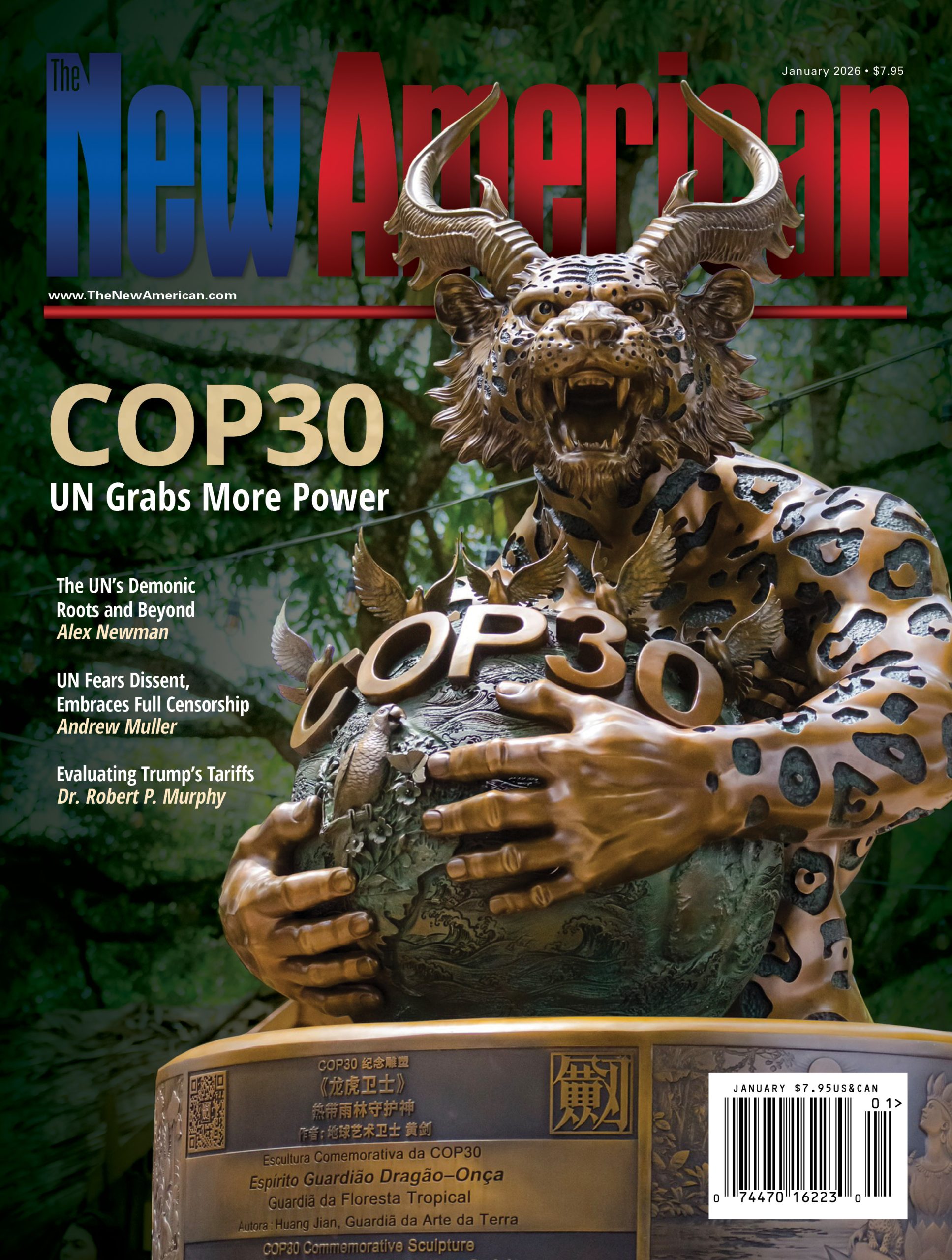
WikiLeaks Confirms North American Integration Scheme
A secret U.S. embassy cable from 2005 released on April 28 by the anti-secrecy group Wiki-Leaks confirms what The New American magazine and others have been reporting for years: North American governments are indeed plotting to “integrate” the continent. And not even including implementing the North American Free Trade Agreement (NAFTA), they’ve been working on it for at least six years, probably more.
So far, however, the bombshell has barely attracted any attention in the United States, Canada, or Mexico beyond a few mentions in some liberty-minded Internet forums and a TNA online article posted on May 2. But among patriots who have been opposing the integration efforts only to be dismissed as “conspiracy theorists,” the leaked cable provides more concrete proof that the plan is real, dangerous, and more than a recent or transient phenomenon.
The official document, signed by then-American Ambassador to Canada Paul Cellucci, outlines the best ways to peddle the scheme to policymakers and the public. Most alarming to critics, it also discusses ways of getting around national constitutions and even the possibility of an eventual “monetary union.” Numerous other topics are broached in the leaked document, too: borders, labor, regulations, and more. But how to push the integration agenda is featured particularly prominently.
“Integrating” the United States, Canada, and Mexico
Integration is a little-used term employed mainly by policy wonks. But while it may sound relatively harmless, it generally describes a very serious phenomenon when used in a geopolitical context — the gradual merging of separate countries under a regional authority. Similar processes are already well under way in Europe, Africa, and South America. And according to critics, the results — essentially abolishing national sovereignty in favor of supranational, unaccountable governance — have been an unmitigated disaster.
“The European Union has effectively destroyed the independence of its 27 member nations. The plan to create what critics have dubbed a North American Union (NAU) is a huge step toward accomplishing for our nation and its neighbors what the EU has done in Europe,” said John F. McManus, president of The John Birch Society, which has been at the forefront of sounding the alarm about the integration plan. “If successful, the promoters of the NAU will cancel the U.S. Declaration of Independence and bore a huge hole in the U.S. Constitution. This must not be permitted.”
But the insiders in the U.S. government think otherwise. In North America, integration has been proceeding rapidly for years. In 2006, The New American was among the first to report on the efforts to submerge Canada, the United States, and Mexico in what opponents called a “North American Union.” In a special issue dedicated to the subject, a series of articles laid out every facet of the plan; its similarities to the European integration model; the planned “NAFTA Super Highway”; and finally, the end game — a world of supranational regional governments eventually merged into a United Nations-supervised global government.
The special issue attracted a great deal of attention. Over one million copies, in both physical and electronic form, were distributed across America. Finally, even some TV commentators such as then-CNN’s Lou Dobbs exposed the subject, too. The integration plans eventually faded to the back burner of public consciousness, with an occasional smear against those who acknowledged that the plan even existed. But more recently, the topic has received a little more attention — especially in Canada. And even though documents leaked earlier this year revealed that governments were trying to keep the process under wraps, integration is now proceeding out in the open for the most part.
The Cable
Written in 2005, the cable released recently by WikiLeaks explains how “integration” should proceed. And looking back, the document is right on the mark. The best way forward, it argues, is via gradual steps.
Under the subject line “Placing a new North American Initiative in its economic policy context,” American diplomatic personnel in Canada say they believe the slow and steady path is best. “An incremental and pragmatic package of tasks for a new North American Initiative (NAI) will likely gain the most support among Canadian policymakers,” the cable states in its summary. Apparently Canadian economists agree.
How integration backers should peddle the scheme is seemingly one of the primary purposes of the document. The cable touts, for example, the supposed benefits of merging the three countries — intended to be essentially “talking points” to sell the plan. It even mentions which elements of the plan to “stress” in future “efforts to promote further integration.”
“Our research leads us to conclude that such a package should tackle both ‘security’ and ‘prosperity’ goals,” the document claims, using the two key words that have been emphasized at every step along the way. “This fits the recommendations of Canadian economists who have assessed the options for continental integration.”
Toward the end, the cable offers more advice on how to advance the integration agenda by tailoring the narrative. “When advocating [the North American Initiative to integrate the three countries], it would be better to highlight specific gains to individual firms, industries or travelers, and especially consumers,” the cable states, noting that it’s harder to “estimate the benefits” on a national or continental scale.
Unsubstantiated Claims
In a section of the document headlined “North American Integration: What We Know,” the cable offers nothing but praise for the merging of the continent’s once-sovereign nations. “Past integration (not just NAFTA but also many bilateral and unilateral steps) has increased trade, economic growth, and productivity,” it claims. But countless economists disagree. Acclaimed free-market economist Murray Rothbard, for example, blasted NAFTA. “It’s worse than open socialism; for it’s internationalist socialism camouflaged in the fair clothing of freedom and free markets,” he wrote, calling the agreement “government-directed, government-negotiated trade, which is mercantilism, not free trade.” And of course, true free-trade advocates also correctly point out that the thousands of pages of regulations making up the agreements should hardly be considered examples of genuine free trade.
So-called “security,” the other big integration selling point, is featured prominently in the document as well. “A stronger continental ‘security perimeter’ can strengthen economic performance,” the cable states. “It could also facilitate future steps toward trilateral economic integration, such as a common external tariff or a customs union.”
And law-enforcement “cooperation” is good too, claim the embassy and the U.S. Ambassador, matter-of-factly. “Cooperative measures on the ‘security’ side, a critical focus of current bilateral efforts, can deliver substantial, early, and widespread economic benefits,” the cable alleges, offering no evidence to substantiate the assertions. “Security and law enforcement within North America have evolved rapidly since 9/11,” it continues. “Collaboration to improve these processes could yield efficiency improvements which would automatically be spread widely across the economy, leading to general gains in trade, productivity, and incomes.” According to this line of thinking, integrating and consolidating police powers with our neighbors to the north and south will somehow not only make us safer, but more prosperous to boot. Those claims are easily demolished by observing the effects of the U.S. government’s “Merida Initiative,” which purports to fight drug trafficking in Mexico — a country where 40,000 innocent victims have been murdered in recent years as a result of the drug war, even as drug imports continue to soar.
The Alleged “Consensus”
The cable devotes considerable space to listing what it claims is a summary of the “consensus” among Canadian economists. According to the document, “many” economists agree with the scheme. Apparently they also support the principle of “more ambitious integration goals” such as a customs union, a single market, and even a continental currency to replace the dollar. On top of that, they supposedly believe such a union should involve all three major North American countries: the United States, Mexico, and Canada.
The cable also cautions, however, that “most” of the economists believe the gradual approach is “most appropriate” — for now, at least. And all of them reportedly agree that such an approach “helps pave the way to these goals if and when North Americans choose to pursue them.”
The embassy cable also includes a summary of what it calls the “professional consensus” among Canadian economists on various individual issues related to the scheme. “At this time, an ‘incremental’ approach to integration is probably better than a ‘big deal’ approach,” the document states under the “process” subheading, supposedly referring to the economists’ opinions. “However, governments should focus on choosing their objectives, and not on choosing a process.” [Emphasis added.]
The next summary in the cable is about the question of “border vs. perimeter,” as the formerly secret document puts it. “Even with zero tariffs, our land borders have strong commercial effects,” the embassy says. However, “some” of the effects — such as law enforcement and “data gathering” — are described as “positive.”
“Canada and the United States already share a security perimeter to some degree; it is just a question of how strong we want to make it,” the 2005 document notes. Apparently Canadians’ main reason for seeking a perimeter approach to security and borders, as opposed to a border between the two nations, is to avoid the “risk” that “discretionary” U.S. decisions to stop terror or disease might impede commerce. And evidently, the nations’ rulers did recently decide to make the perimeter stronger. They even held a press conference about their agreement. More on this press conference later in the article.
The cable also claims the “economists” support a customs union beyond what NAFTA offers, a feature developed in the European Union once the integration process was well established. “A common external tariff, or a customs union which eliminates NAFTA’s rules of origin (ROO), is economically desirable,” it states. And in terms of labor markets, the so-called “consensus” among the unidentified Canadian economists is also — surprise! — the pursuit of even more integration. “Many Canadian economists point to labor markets — both within and among countries — as the factor market [sic] where more liberalization would deliver the greatest economic benefits for all three countries,” the document states.
Commenting on the new WikiLeaks revelations, William Gheen, president of Americans for Legal Immigration (ALIPAC), said the planned merger was one of the motives for failing to secure the southern U.S. border. “This is why these elite banking, business, and political influences are flooding America with rampant illegal immigration and hyper legal immigration,” he explained. “They are conquering the freedom-loving innocent citizens of America by bringing in outsiders who will replace us incrementally in our jobs and homes.”
Next, the cable released by WikiLeaks highlights another startling proposition about how to achieve an end-run around the Canadian Constitution. “Inter-provincial differences [in regulation] are important here, since Canada’s federal government does not have the benefit of a U.S.-style ‘interstate commerce’ clause,” the document states. “While much of the problem is domestic in nature, an international initiative could help to catalyze change.” Yes, the U.S. embassy refers to the wildly abused and misapplied “commerce clause” as a “benefit” that Canada lacks. And it actually suggests — hiding behind unnamed “economists” — that the constitutional “problem” could be minimized by foisting an “international initiative” on the Canadian people.
Finally, the document summarizes the “consensus” on the subject of a currency union. It says the supposed economists were “split” on the issues of returning to fixed exchange rates or even abolishing Canada’s fiat dollar and replacing it with America’s Federal Reserve fiat currency. The cable gives the final word on the topic of a currency union to the Canadian central bank boss. He is quoted as saying that “monetary union is an issue that should be considered once we have made more progress towards establishing a single market.”
History, Progress
With the creation of the North American Free Trade Agreement — similar in many ways to the European Common Market that preceded the political union in Europe — the foundation was laid. And from there, integration only accelerated. Especially after the open and public support of the ruling establishment.
The scheme to merge North America into a political unit with its own legislature and currency is largely the brainchild of the world government-promoting Council on Foreign Relations. In March of 2005, the infamous CFR foreign-policy cabal produced a document entitled Creating a North American Community: Chairmen’s Statement Independent Task Force on the Future of North America.
The report called for the creation of a “community” for the supposed purpose of enhancing “security, prosperity, and opportunity for all North Americans.” And since then, the campaign to integrate North America has continued full-speed ahead as a fully bipartisan phenomenon. Under President George W. Bush, for example, integration occurred through the little-known “Security and Prosperity Partnership of North America.”
Now, under the Obama administration, the process is virtually out in the open, despite a glaring lack of coverage from establishment news outlets. As The New American online reported in February, Obama and Canadian Prime Minister Stephen Harper met in Washington, D.C., to hammer out a deal on solidifying a common “perimeter” around the two countries. Also part of the agreement, which conspicuously bypassed both countries’ legislatures, was a diminished role for the nations’ shared border. The development of a biometric system to track North Americans was agreed to as well, as were numerous other controversial measures.
Amazingly, the two leaders even held a press conference about the deal after it was concluded. But as usual, almost all of the press coverage that did mention the scheme failed to explain the importance of what was going on. In fact, most of the media — probably taking their cue from Obama, who touched on Egypt before starting the Q&A session — focused on the North African turmoil instead of the new North American security perimeter and its gargantuan implications.
Revelations, Future
Since the TNA online article about the cables was published, thousands of blogs and alternative media outlets have picked up the story. The WikiLeaks document is being treated by analysts and activists as a sort of “smoking gun” about what insiders once tried to dismiss as a “conspiracy theory.”
“These latest revelations only substantiate what we have been saying for several years, that there is a plan to merge North America to the detriment of the independence of the American people and our constitutionally protected rights,” said CEO Art Thompson of The John Birch Society. “The argument that it has improved our economy and industry is false; just ask those who are out of work. Being unemployed is only the beginning of the woes that will be created by this merger.”
ALIPAC sent out a press release on May 18 driving the point home. “It is conspiracy, but it is no theory,” said the organization’s president. “These traitors are trying to conceal their plans, but they are out in the open now. They are trying to force an economic union on America that is not ratified by the US Congress, not authorized by the US Constitution, and not approved of by the American public.”
But to stop the scheme, a lot of work remains. If it is to be derailed, Americans and Canadians must be aware of the looming danger. Where the integration campaign will eventually end remains to be seen. But if North American Union advocates get their way, the U.S. Constitution and its Mexican and Canadian counterparts could soon be rendered irrelevant. After that — critics and supporters both agree — plugging the regional units into a global system would be a relatively simple matter. Then, the America that Americans love would essentially be no more.




